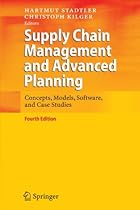Supply Chain Management and Advanced Planning: Concepts, Models, Software, and Case Studies

| Author | : | |
| Rating | : | 4.56 (898 Votes) |
| Asin | : | 3642093922 |
| Format Type | : | paperback |
| Number of Pages | : | 556 Pages |
| Publish Date | : | 2016-11-03 |
| Language | : | English |
DESCRIPTION:
556 page book is well written and was in good shape till the seller Student for Life The 556 page book is well written and was in good shape till the seller, textbooksrus.com put a large USED label in black, white and green colors over the spine of the book. This makes it impossible to take off the large label, which completely covers the book title when it sits vertically on the book shelf. There is also a r. Auli Sakko said Very good book. I can sincerely say that this book is very very good and I gives a clear picture from the SCM
Understanding is enhanced by several case studies covering a wide range of industrial sectors. Special emphasis is given to modeling supply chains and implementing APS successfully in industry. . This book, already in its fourth edition, gives a broad and up-to-date overview of the concepts underlying APS. The fourth edition contains updated material, rewritten chapters and additional case studies. From the Back Cover Supply Chain Management, Enterprise Resources Planning (ERP), and Advanced Planning Systems (APS) are important concepts in order to organize and optimize the fl
What makes this book so crucial is that Supply Chain Management, Enterprise Resources Planning (ERP), and Advanced Planning Systems (APS) are concepts that must be mastered in order to organize and optimize the flow of goods, materials, information and funds. With a wealth of updated material, rewritten chapters and additional case studies, this fourth edition of a hugely important work gives a broad and up-to-date overview of the concepts underlying APS. Here, leading experts provide insights into the concepts underlying APS.. Special emphasis is given to modeling supply chains and implementing APS successfully in industrial contexts. What’s
